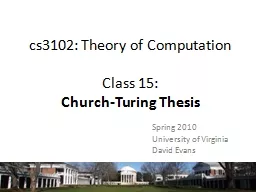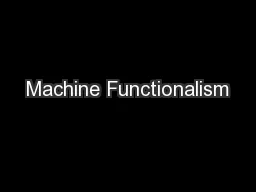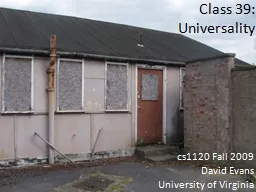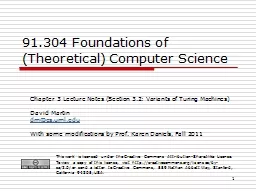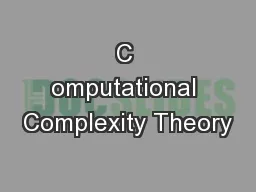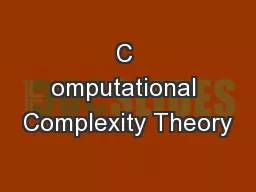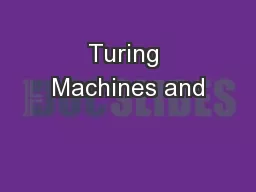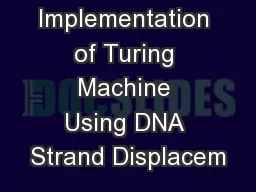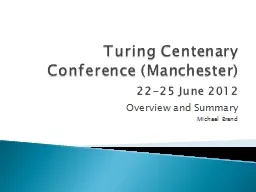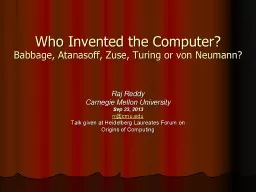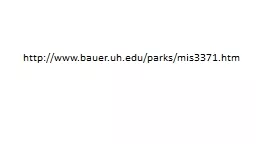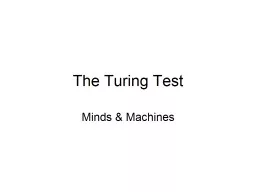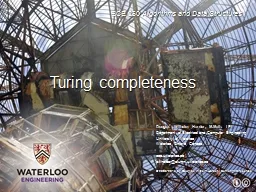PPT-Turing
Author : mitsue-stanley | Published Date : 2016-08-03
Machines Recursive and Recursively Enumerable Languages Turing Machine 1 TuringMachine Theory The purpose of the theory of Turing machines is to prove that certain
Presentation Embed Code
Download Presentation
Download Presentation The PPT/PDF document "Turing" is the property of its rightful owner. Permission is granted to download and print the materials on this website for personal, non-commercial use only, and to display it on your personal computer provided you do not modify the materials and that you retain all copyright notices contained in the materials. By downloading content from our website, you accept the terms of this agreement.
Turing: Transcript
Machines Recursive and Recursively Enumerable Languages Turing Machine 1 TuringMachine Theory The purpose of the theory of Turing machines is to prove that certain specific languages have no algorithm. M Turing 1950 Computing Machinery and Intellig ence Mind 49 433460 COMPUTING MACHINERY AND INTELLIGENCE By A M Turing 1 The Imit ation Gam I propose to consider the question Can m achines think This sh Class 15: . Church-Turing Thesis. Spring 2010. University of Virginia. David Evans. Turing . Machine Recap. . . .. FSM. Defining. TM Computing Model. . . .. FSM. TM Computing Model. Drawing Turing Machines. What we have learned. The failures of dualism, behaviorism, and identity theory were not in vain!. Each failure reveals important features of mental states that any theory ought to be able to handle.. Universality. cs1120 Fall 2009. David Evans. University of Virginia. Menu. Recap Turing Machine from last class. Halting Problem for Turing Machines:. Proof that the Halting Problem for TMs is . noncomputable. Chapter 3 Lecture Notes (Section 3.2: Variants of Turing Machines). David Martin. dm@cs.uml.edu. With some modifications by Prof. Karen Daniels, Fall 2011. This work is licensed under the Creative Commons Attribution-ShareAlike License. To view a copy of this license, visit http://creativecommons.org/licenses/by-sa/2.0/ or send a letter to Creative Commons, 559 Nathan Abbott Way, Stanford, California 94305, USA.. Lecture 1: . Intro; Turing machines; . Class P and NP . . . Indian Institute of Science. About the course. Computational complexity attempts . to classify computational . problems. Lecture 1: . Intro; Turing machines; . Class P and NP . . . Indian Institute of Science. About the course. Computational complexity attempts . to classify computational . problems. the Halting Problem. This work is licensed under the Creative Commons Attribution-. NonCommercial. -. ShareAlike. 3.0 . Unported. License. To view a copy of this license, visit http://creativecommons.org/licenses/by-nc-sa/3.0/ or send a letter to Creative Commons, 444 Castro Street, Suite 900, Mountain View, California, 94041, USA.. Wataru. . Yahiro. and Masami . Hagiya. The University of Tokyo. . December . 12-13, . 2016. TPNC 2016 at Sendai. Outline. Background. DNA Strand Displacement. Space-bounded Computation with DNA. Space-unbounded . . 22-25 June 2012. Overview and Summary. Michael Brand. Manchester town hall. Venue. The 12 “Manchester Murals”. Color-lit. 16-foot. pipe organ. Stars & planets depicted in . mozaic. City & country crests. Babbage, . Atanasoff. , . Zuse. , Turing or . v. on Neumann?. Raj . Reddy. Carnegie Mellon University. Sep 23, 2013. rr@cmu.edu. Talk given at Heidelberg Laureates Forum on. Origins . of Computing. 3 Stages of Information Revolution. . This is . THE. book!. THE HERO OF THIS STORY. Alan . Mathison. Turing (1912-1954). Who conceived the idea of the computer . in a field of flowers in 1935. And who we owe credit for computers and how they. The Turing Test Minds & Machines Alan Turing British mathematician known for: Turing Machines (1936) Breaking German Enigma (WWII) Turing Test (1950) ? “I propose to consider the question, 'Can machines think?' This should begin with definitions of the meaning of the terms 'machine 'and 'think'. … [But] Instead of attempting such a definition I shall replace the question by another... The new form of the problem can be described in terms of a game which we call the 'imitation game'.“ In this topic, we will:. Ask what is computable. Describe a Turing machine. Define Turing completeness. Computability. How do we define what is and what is not computable?. Is it possible to write a C++ function which cannot be written using Pascal, Java, or C#, or vice versa?.
Download Document
Here is the link to download the presentation.
"Turing"The content belongs to its owner. You may download and print it for personal use, without modification, and keep all copyright notices. By downloading, you agree to these terms.
Related Documents


